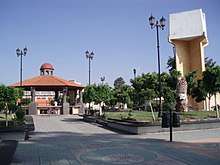Santiago Teyahualco
Santiago Teyahualco is the second-largest town in the municipality of Tultepec in the state of México in Mexico. At the Mexican census of 2005 the town reported a population of 47,547 inhabitants. Santiago Teyahualco, is a town located in Tultepec, State of Mexico, Mexico. It has a population of 47547 people, of which 23357 are men and 24190 women. It is characterized mainly by its feast to the patron saint of the town (Santiago Apostol) where you can enjoy a kery with local food, castles, bulls, and fireworks.

History
The name Teyahualco comes from Toyahualco, which underwent transformations over time (they were names from Nahuatl or Mexican, which were distorted by Spanish conquest and evangelization); it means "in the bushes of Tule or place of bushes of Tule"; previously it was formed by four neighborhoods and places: Tecompa, Colostitla, Jajalpa and Tlamimilolpa.
Through the study and analysis of bibliographies related to the indigenous past of the first settlers of the Valley of Mexico and codices, it is now known that in this lacustrine region there were settlements of cultures such as Chichimeca, Tlatelolca and Otomí, which were nomadic tribes and hunters. pilgrims.
In the annals of Cuautitlan, codex Chimapopolca, it is mentioned that in the year one Tecpatl (year 804 d.C.) the Chichimecas cuatitlanenses established the lordship of this valley, for its abundant water, flora, fauna and fishing. It is said that during these times, the population was about 12 families. During the colonial period, some original places were given a Spanish name, such as:
Mitra, El Solar, La Pera, Calicanto, El Magueyal, El Vado, La Huerta, Sarabia, La Presa Blanca; El Paredon and La Manzana.
In these sixteenth and seventeenth centuries, the population was 18 to 20 families.
In January 1899, during the Porfiriato, the government issued certificates of ownership to the residents of Toyahualco "Titulos Justificativos", which specifically established the names of the neighborhoods and original sites of the pre-Hispanic and colonial times. Currently, there are families from the town, who still preserve these documents, characterized in particular by the fact that the eagle of the national coat of arms appears in front.
Culture
Cuasiparroquia "Santiago Apóstol" It is one of the four vicars that make up the Diocese of Cuautitlán, comprising mostly parishes located in the municipalities of Melchor Ocampo, Cuautitlán, Tultepec and Tultitlán in the State of Mexico. It is located in the center of the town, it is characteristic of the place for its years of antiquity, which oscillate between 200 and 150 years.
Gastronomy
Tamales is a traditional Mesoamerican dish made of “masa” or dough (starchy, and usually corn-based), which is steamed in a corn husk or banana leaf Barbacoa ; the method of cooking is pre-Columbian. Basically, it is a traditional method used to prepare various meats, especially sheep, cooked in their own juice or steamed. Carnitas ;they are different portions of pork meat and are prepared by frying these pieces in lard. Sweet bread: It is the so-called 'biscuit bread' or 'sugar bread' to the variety of bread made with some particular characteristic, which commonly owe its popular name and that differentiate them from the so-called white bread or "sweet bread". The sweet bread is distinguished by its preparation and final presentation of other breads such as birotes, teleras and bolillos, and box bread.
Traditions and holidays
Fiesta Patronal del Día de la Candelaria (2 de febrero)
This is the religious holidayThroughout Mexico on this date, people dress up figures of the Christ Child in special outfits and take them to the church to be blessed, and they also get together with family and friends to eat tamales Fiesta Patronal en honor a Santiago Apóstol
It takes place on July 25 of each year. The locality performs rites of devotion in the Patron Saint, Santiago Apostle, accompanied by parties such as baptisms, weddings, XV years, First Communion, Confirmation and kermes with mechanical games, fireworks, masses, processions and food.
Pyrotechnic bulls
It is a metal frame, which imitates the shape of a bull, on which spine a frame with pyrotechnic elements is placed.
It is transported by a person, who transmits a wick, correlates with frightened people with the sparks that these bulls release.
Other social phenomena
1.54% of the population is indigenous, and 0.75% of the inhabitants speak an indigenous language. 0.00% of the population speaks an indigenous language and does not speak Spanish. 39.64% of the population over 12 years of age is employed (52.37% of men and 27.41% of women). Of the total population, 46.01% comes from outside the State of Mexico. 0.67% of the population is illiterate (0.48% of men and 0.85% of women). The level of schooling is 10.81 (11.02 in men and 10.60 in women). In Santiago Teyahualco there are 20290 homes. Of these, 99.47% have electricity, 98.35% have piped water, 98.61% have a toilet or toilet, 90.36% radio, 98.56% television, 94.31% refrigerator, 85.25% washing machine, 53.05% automobile, 51.73% a personal computer, 63.22% fixed telephone, 81.76% cell phone, and 36.62% Internet
References
- Link to tables of population data from Census of 2005 INEGI: Instituto Nacional de Estadística, Geografía e Informática
- Tamal. (2019, February 08). Retrieved from https://es.wikipedia.org/wiki/Tamal
- Barbacoa (México). (2019, February 08). Retrieved from https://es.wikipedia.org/wiki/Barbacoa